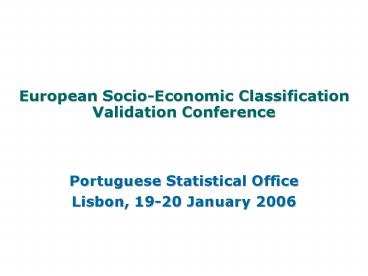European SocioEconomic Classification Validation Conference - PowerPoint PPT Presentation
1 / 27
Title:
European SocioEconomic Classification Validation Conference
Description:
1: Higher salariat occupations. IT. UK. DE. DK. Country ... 1: Higher salariat occupations. Two digits. Three digits. Four digits. Isco version. ESeC Classes ... – PowerPoint PPT presentation
Number of Views:72
Avg rating:3.0/5.0
Title: European SocioEconomic Classification Validation Conference
1
European Socio-Economic Classification
Validation Conference
- Portuguese Statistical Office
- Lisbon, 19-20 January 2006
2
Unemployment risks in four European countries an
attempt of testing the construct validityof the
ESeC scheme
- Antonio Schizzerotto, Roberta Barone
- Laura Arosio
- University of Milano Bicocca
- Italy
3
Aims of the study
- Testing the construct validity of the ESeC
classification, by means of a comparative
analysis aimed at detecting the variations across
four EU-15 countries in the risks of unemployment
experienced by incumbents of occupations
belonging to different ESeC classes. - Checking whether in the case of Italy different
versions of Isco88.com- i.e. 2, 3 and 4 digit
versions- affect the estimated disparities
between ESeC classes in the risk of unemployment
4
Four EU countries
- Denmark, as a representative of countries where
the State playes an important role in the
functioning of the whole society - Germany and Italy, as representatives of
countries where family has a crucial position in
the institutional arrangements of the society - United Kingdom, as a representative of countries
that attribute great importance to the market in
the workings of the society
5
Three hypotheses to be tested
- ESeC is a valid social scheme
- The disparities between ESeC classes in the risk
of unemployment should follow the same general
pattern between countries that posses a market
economy - Despite this basic similarity, as a consequence
of different institutional arrangements and
labour market regulations across countries, one
should observe between countries dissimilarities
in unemployment risks displayed by each ESeC
class.
6
Data sources
- Waves from 1994 to 2001 of the European Community
Households Panel (ECHP) - Waves 1997, 1999 and 2001 of Ilfi (Italian
Households Longitudinal Study)
7
Methods
- Poisson regression of unemployment incident rates
ratios - Survivor functions in employment by ESeC classes
8
ESeC classes and risks of unemployment
9
Poisson Regression of Unemployment Incidence Rate
Ratios by ESeC Classes and Country in the period
1994-2001
10
Average incidence rates () of unemployment (in
bold letters) and 95 confidence intervals by
ESeC classes and countries in the period
1994-2001
11
Poisson regression of unemployment incidence rate
ratios by ESeC classes and country controlling
for gender, age, level of education and marital
status. ECHP waves 1-7
12
Average incidence rates () of unemployment (in
bold letters) and 95 confidence intervals by
ESeC classes and countries in the period
1994-2001. Estimates from multivariate Poisson
regression model controlling for gender, age,
education and civil status.
13
ESeC classes and the duration of employment
episodes
14
(No Transcript)
15
(No Transcript)
16
(No Transcript)
17
(No Transcript)
18
Log-rank test of expected and observed events of
dismissal by ESeC classes and country and values
of ?2 test.
19
The validity of ESeC class scheme and Isco 88
com versions according to Ilfi data
20
ESeC classes size (in percentages) by Isco 88 com
version. Italy, 2001 (current occupation)
21
ESeC classes size (in percentages) by Isco 88 com
version. Working episodes, Italy 1980-2001
22
Poisson regression of unemployment incidence rate
ratios by Isco 88 com version. Italy 1980-2001
23
Average unemployment incidence rates () by Isco
88 com version. Italy 1980-2001
24
Employment relations and level of social
desirability of ESeC classes according to ILFI
data
25
ESeC classes by type of contract, Italy,
1980-2001.
26
Employment status of ESeC classes 1 and 2, Italy,
1980-2001.
27
Scales score by ESeC classes , Italy,
1980-2001.































